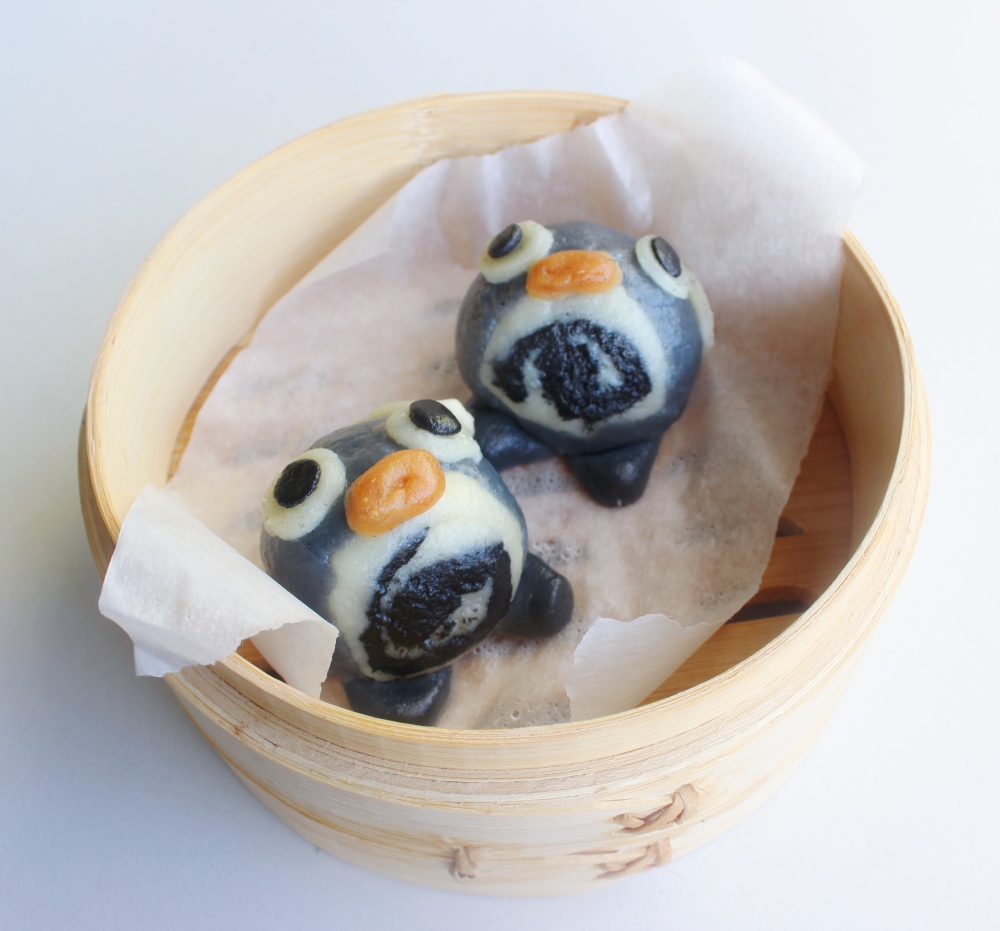When I think of cute O.G./Gen 1 Pokemon, Poliwag immediately comes to mind. Mostly because I remember accidentally running them over in Pokemon Snap in the River stage(whoops), and seeing Misty’s Poliwag(which managed to make it all the way to a Politoed!) back in the original anime series. Poliwag are these round, blue tadpole-like Pokemon with little feet and a characteristic white and black swirl pattern on its stomach(apparently the real-life inspiration is supposed to be tadpole intestines, so yuck, but all of its evolutions have the pattern too). On a less intestines-y note, because of how round and simple Poliwag’s design was, I figured it would be a fairly easy Pokemon to replicate in some sort of dessert! With Poliwag, you have a round blue body, two blue nubs which are its feet, pink round lips, two white ovular eyes with one black iris in each, a white tail, and the white and black spiral pattern on its stomach. The one major challenge for me would be the spiral pattern, but beyond that, I figured something mochi-like would be the perfect way to capture most, if not all, of Poliwag’s features. I opted for tang yuan, which are Chinese sweet rice dumplings that swim in a dessert broth, as a way to sort of capture Poliwag in its natural environment, which would be some kind of pond or lake.

With the components, we have the Poliwag tang yuan, a salted coconut milk, and a sweet pandan gelee. The tang yuan themselves are made with mochiko(glutinous rice flour) and silken tofu, which gives them a chewy texture, but also results in a sturdier, easier to mold dough. I dyed the dough using blue spirulina powder, activated charcoal, and red beet powder to get the blues, blacks, and pinks I needed for Poliwag’s features. The spiral, I went with a similar technique I used with making cinnamon rolls, by rolling a black dough into a white dough and cutting it. Admittedly, my dough was a bit wetter than I wanted it to be(the recipe you have in this post adjusted for that), so my spirals did smear a bit, but I was okay enough with them to press forward with what I wound up photographing. The tang yuan are traditionally boiled or poached, but I opted to steam mine, since steaming reduces the risk of Poliwags lips, eyes, feet, or tail from being torn off(I learned that lesson with the Dratini tteok). The broth is a salted coconut milk, because I wanted to go with more Southeast Asian flavors on this dessert. It has been really warm in L.A. lately, and I wanted something really refreshing and cooling, and coconut milk does that for me. I also wanted to use pandan specifically, since the pandan gelee resembles the salveyo weed that Poliwag are known to feed on in the anime! All in all, these tang yuan were light, refreshing, 100% naturally colored, and surprisingly, gluten-free and vegan, all on top of looking like adorable little Poliwag!

Makes 8 Poliwag tang yuan:
120g mochiko
135g puréed silken tofu
a pinch of salt
Blue spirulina powder
Activated charcoal powder
Red beet powder
corn starch or potato starch
In a bowl, mix together the mochiko, tofu, and salt. Portion out about 100g of the dough and mix into that butterfly pea and activated charcoal until the dough forms a dark blue hue. With 100g of the remaining dough, split that into four, dying one portion black with the activated charcoal, and keeping the remaining three portions white. With the remaining dough, mix in the beet powder until it is a light pink color. You should have four different balls of dough – one blue, one black, one white, and one light pink.
On a corn/potato starch-lined surface, roll out 20g of the black dough into a rectangle. Then roll out 30g of the white dough into a rectangle of a similar width, but longer than the black. Place the black dough onto the white dough and roll both doughs up into a scroll. Using a very sharp knife and a cutting board, slice the scroll into 8 log-like pieces.
Divide 80g of the blue dough into 8 disks, and wrap each around the black and white-spiraled logs to form the bodies of your Poliwags. Divide up the remaining blue dough into 16 small balls, and attach each to the bottom of the Poliwags to form their feet. With the remaining white dough, roll out and cut out the tails and eyes, attaching them to the Poliwags using a little bit of water as necessary. Then add on the irises to the eyes using the remainder of your black dough. Optionally, you can free the Poliwag tang yuan prior to cooking them.
Transfer the tang yuan to a parchment and cooking spray-lined bamboo steamer, and steam on medium heat for 15 minutes.
For the pandan gelee:
1/2 cup water
2 tbsp granulated sugar
2 drops pandan extract
a pinch of salt
1/2 tsp agar agar
In a pot on medium-high heat, bring everything to a simmer. Once the sugar and agar have dissolved into the water, pour the liquid into a shallow sheet tray and refrigerate for 10 minutes. The gelee should be solidified at this point. Chop into thin strands.
For the coconut milk:
1/2 cup coconut milk
a pinch of salt
Bring coconut and salt to a simmer. Allow the milk to cool down to lukewarm before plating.
